
The most visible artifacts of some acorn worms are the spaghetti mounds common in some sandy areas. The sand has been processed though the gut of a fairly large buried worm whose posterior end points up. As the worm passes sand through its gut, it gets packaged with a bit of mucus that holds it together in a tube and it is pushed out the top of the mound. At the very top of the first photo below, the sand tube that extends down into the mound is where it is being slowly pushed out. If you sit and watch one of these in action for a few minutes, you can see the sand tube slowly emerging. The only way to see the worm itself is to sweep away the accumulating sand and, if you are quick enough, you might see the posterior end of the worm retracting back down into the sand. We have also seen these called Ptychodera flava; they may be, but we are keeping them separate because of their larger size and the production of the spaghetti mounds, both different characteristics from the Ptychodera flava we figure elsewhere.

The posterior end of one of the worms, still pushing out sand as it retracts after being exposed. These tubular bodies, a good 15 to 20mm in diameter, are much larger than those of what we are calling Ptychodera flava, and look too solid to be those smaller worms stretched out.


The mounds do not last too long. The mucus holding them together dissolves and the sand tubes sag, eventually becoming piles of sand.

The sand dwelling mollusk Oxymeris crenulata seems to exclusively prey upon acorn worms.

Created 16 February 2019